
whohah
-
Posts
129 -
Joined
-
Last visited
Content Type
Profiles
Forums
Gallery
Events
Articles
Posts posted by whohah
-
-
IMHO, the multiple chopped notes have been thru many different money exchange shops. These shops may be quite distant from each other so the various shops may not recognize the chop of a different shop.
As I said, JMHO...
-
I am a generalist with coins of special interest that I hoard...
-
For some insight into the 'private' minting process, see these websites:
and
http://www.grasshoppernet.com/walrafen/gmm.html
The first is the website of the Gallery Mint Museum which is located in Eureka Springs, Arkansas. These guys make very good replicas of early US coinage , etc., using the old methods. The second site is a website run by Gallery Mint's biggest fan. In it are many illustration of various Gallery Mint products made in very limited production runs.
HTH...
-
I got mine today [July 5], too!!
-
I, too, started with stamps 'way back in 1956. By late-1958, I'd discovered that I couldn't keep up with the output of US stamps, much less world stamps. I still like US colonial issues, emergency issues, revenues, tax stamps, etc.
I buy commems to use on my postage and I insist on using stamps instead of the meter prints the Post Office has when I send a certified letter.
I prefer using engraved stamps; however, those seem to be few and far between now.
I'm still sitting on a sheet of 150 of the tiny Indian Head Cent stamp [13 cents each] from the mid-1970's [150 to the sheet].
-
I say keep all the present coined denominations and add $2, $5, $10 & $20 coins. The $10 and $20 could contain a fairly high fineness of silver and still circulate.
Keep the present paper denominations, just don't print as many. {Was that sound the sound of the various BEP Unions flipping out?}
No politician in the US will sign on to any bill removing George from our lives, paper or coin.
Regarding the 'amount' of copper in all those hoarded cents:
Since mid-1982, there's practically no copper in a cent any more. IIRC, they are 99+% zinc with a copper plating. The zinc production industry LOVES it...
Oh, well, just my US$0.02 [2 Zinclons] worth...
-
Oh ok! Thanks guys! SSo is there any way to actually tell what year it is from?
Well, MacArthur's troops brought them in when they landed in October of 1944. After that they were issued either as issues under the US ['till July 4, 1946] or as issues of the Central Bank of the Phillipines up to 1949. So, their years of issue would be 1944 to 1949.
-
I will immediately search out an appropriate note for my '05 SS.
I may use an old Russian 100 rouble note [a biggie].
But, I'll just have to sort thru what I have...
-
But I have seen more notes like it with different dates...I have seen one from 1922, 1936, and 1945 on ebay.
Nope. The 1922 date is for the original legislation authorizing the issue of Philippine Treasury notes. There were subsequent series dates [1924, 1929, 1936, 1941] related to changes in the signatures and creation of the Commonwealth. The "Victory" series are the only one's with blue serials and seals. There were no earlier series which were overprinted with the big black "Victory" on the back. Any earlier series which have such are spurious, unofficial issues.
After the war, the Central Bamk overprinted the notes on hand. Which brings to mind a very serious issue in my mind, being, how did they overprint so many single notes and keep such a consistant registry of the overprint? Overprinting sheets is less of a problem because a sheet is larger and easier to feed into a press.
HTH...
-
Since 1958.
I got interested in the 'new' Lincoln Memorial reverse for the cent. I was 10 and, through stamp collecting, was watching for the commemorative stamps coming out for Lincoln's 150th anniversary of birth. Some article [probably in the Dallas Morning News] mentioned the change for the cent and I got interested.
What really hooked me was when my best friend's dad [a long time nummismatist] took a look at my family's 'heirloom' coin. Ya' know, every family has at least one. It may be from Gran'pa's world tour courtesy Uncle Sam's disagreement with Adolph, Benito and Hirohito in the early 1940's, or Dad's visit to SE Asia in the '60's and '70's in the attempt to make the world safe for dominos. Or whatever...
Our family's coin was one of Gran'ma's dollars which survived a house fire in 1918. She had sold the eggs that day and the money was in her dresser. After the fire, they sifted the ashes and found the dollars and never spent them. In the early 1950's, Gran'ma and Gran'pa decided to give one to each of their children.
As it turned out, my dad got the 1889-CC.
And now you know the '...rest of the story...'
-
Please sign me up for a set.
I believe Art has my snail-mail addy.
Jay
-
Observation of the solder marks on the rim lead me to believe that this was once a part of a ring.
Just MHO and US$0.02 worth...
-
Here's an interesting number on a USBEP printed Cuban 10 peso note I have. I never noticed the number when I was bidding on it on eBay. It wasn't until I got the note did I 'note' the serial number...


-
Here's a coin with two 'ships' and an airplane on it, thus, satisfying the ships-on-coins collectors and the airplanes-on-coins collectors.

-
Worth 10K Euros? Well, maybe, but probably not...
With all zeros for a serial number, it sounds like a specimen note. Many central [government] banks produce specimens for limited distribution to other financial institutions as examples of their notes. Therefore, there are not very many of 'em.
As new issues come out, new specimens are distributed. The old specimens are often held by the recipients until the old notes are no longer legal tender. Then, the recipient financial institution may return it to the issueing bank, destroy it or otherwise dispose of it. Since paper money collecting has attained such popularity, these notes are often sold into the marketplace for '...whatever the market will bear...'
Further, many issueing banks realize the popularity of 'specimens' and produce them for collectors.
I have no specific knowledge of the value of a Spanish 1000 peseta note from 1965 or its value as a specimen; however, I'd guess it's 'value' is more in the 200 to 500 Euro range and very possibly a whole lot less. There have been auctions of US Federal Reserve Bank small-sized specimens within the last 6 months or so [Heritage, maybe?]. I do not recall what they were hammered down for. My best guess is in the $5K to $10K range. US notes are far more popular than Spanish notes; so, IMHO, US notes would tend to go for higher prices.
More knowledgable collectors/dealers will have to be consulted...
[Too bad neither of us are in Memphis this weekend, we'd have the answer in a flash!]
-
StuJoe,
YES! YES!! YES!!!
Thank you!!
Jay
-
Did anyone think to 'over-strike' another coin? Seems to me a 2-euro piece would fit nicely...
-
YEEE-HAAAAAHHHHHH!!!
Y'know, a house can be anything that shelters one from the elements;
however, it is the people that make a
HOME!!!!!!!
I'm so glad to be HOME!!!!!
{now if I can just get my avatar and my quote back...}
-
Well, it may not be a hot topic for anyone else; however, how do I get my avatar [Hobbes of 'Calvin and Hobbes'] and my quote under the avatar ["...always willing to learn."] back?
Any assistance will be greatfully appreciated...
Jay
-
A. Indian Head Cent bronze 1864-1909
B. Flying Eagle Cent 1856-1858
C. Lincoln Cent 1909 - 1958
D. Ike Dollar 1971-1978
E. Large cent 1840 or so - 1857
F. Walking Liberty Half Dollar 1916-1947
G. Sacajawea Dollar 2000 - date
H. Shield 5-cent piece - 1866-1883
I. Nickel 3-cent piece 1865-1889
J. Lincoln cent - 1959 to date
Jay in Garrison, TX
[where the heat index was 105 degrees Farenheit today...]
Latest Banknote purchases.
in Banknote Forum
Posted
I believe it is called a "triskelon" and the meaning is that no matter how it is thrown [i.e., what happens to it], it always remains standing [it lands on its foot]. No matter what happens to the Ilse of Man, it will keep going on its own.
Or so I've been told...
Jay, not of Garrison any more